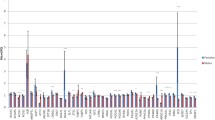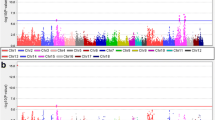Abstract
There is increasing evidence suggesting that fatty acids biosynthesis and metabolism are regulated by peroxisome proliferator-activated receptors (PPARs), mostly through the PPAR signaling pathway at the transcriptomic level. We hypothesized that the genetic variants of the enzymes in the PPAR signaling pathway may be associated with the traits of porcine meat quality (PMQ). We mined 77 potentially functional single nucleotide polymorphisms in the PPAR signaling pathway of the pig. There were 13 TagSNPs in 13 different genes mapped within the reported pig quantitative trait loci (QTLs) regions related to PMQ based on the Pig QTL database. Based on the association study with ten measured PMQ traits in both the pathway level and the SNP level, we tested eight significantly associated traits with additive effect in the PPAR signaling pathway and explored only one significant TagSNP in gene RXRB, which is directly associated with the trait of skin weight. Moreover, several interactions of TagSNPs were also significantly related to some of PMQ traits. In this large and comprehensive candidate gene set study, we found a modest association of genes and SNPs in the PPAR signaling pathway with PMQ. Further investigation of these gene polymorphisms jointly with fatty acid measures and other genetic factors would help us better understand the regulation mechanisms of PMQ.


Similar content being viewed by others
References
Bu L, Salto LM, De Leon KJ, De Leon M (2011) Polymorphisms in fatty acid binding protein 5 show association with type 2 diabetes. Diabetes Res Clin Pract 92:82–91
Bunger M, van den Bosch HM, van der Meijde J, Kersten S, Hooiveld GJ, Muller M (2007) Genome-wide analysis of PPARalpha activation in murine small intestine. Physiol Genomics 30:192–204
Calle ML, Urrea V, Malats N, Van Steen K (2010) mbmdr: an R package for exploring gene-gene interactions associated with binary or quantitative traits. Bioinformatics 26:2198–2199
Gentleman RC, Carey VJ, Bates DM, Bolstad B, Dettling M, Dudoit S, Ellis B, Gautier L, Ge Y, Gentry J, Hornik K, Hothorn T, Huber W, Iacus S, Irizarry R, Leisch F, Li C, Maechler M, Rossini AJ, Sawitzki G, Smith C, Smyth G, Tierney L, Yang JY, Zhang J (2004) Bioconductor: open software development for computational biology and bioinformatics. Genome Biol 5:R80
Gilmour AR, Gogel BJ, Cullis BR, Thompson R (2009) ASReml User Guide Release 3.0. Available at http://www.vsni.co.uk/resources/documentation/asreml-user-guide
He K, Chen Z, Ma Y, Pan Y (2011) Identification of high-copper-responsive target pathways in Atp7b knockout mouse liver by GSEA on microarray data sets. Mamm Genome 22(11–12):703–713
Hovenier R, Brascamp EW, Kanis E, van der Werf JH, Wassenberg AP (1993) Economic values of optimum traits: the example of meat quality in pigs. J Anim Sci 71:1429–1433
Hu ZL, Dracheva S, Jang W, Maglott D, Bastiaansen J, Rothschild MF, Reecy JM (2005) A QTL resource and comparison tool for pigs: PigQTLDB. Mamm Genome 16:792–800
Kersten S, Desvergne B, Wahli W (2000) Roles of PPARs in health and disease. Nature 405:421–424
Lee Y, Yu X, Gonzales F, Mangelsdorf DJ, Wang MY, Richardson C, Witters LA, Unger RH (2002) PPAR alpha is necessary for the lipopenic action of hyperleptinemia on white adipose and liver tissue. Proc Natl Acad Sci USA 99:11848–11853
Liu X, Wang G, Hong X, Tsai HJ, Liu R, Zhang S, Wang H, Pearson C, Ortiz K, Wang D, Hirsch E, Zuckerman B, Wang X (2012) Associations between gene polymorphisms in fatty acid metabolism pathway and preterm delivery in a US urban black population. Hum Genet 131(3):341–351
Lutsenko S, Barnes NL, Bartee MY, Dmitriev OY (2007) Function and regulation of human copper-transporting ATPases. Physiol Rev 87:1011–1046
Michalik L, Auwerx J, Berger JP, Chatterjee VK, Glass CK, Gonzalez FJ, Grimaldi PA, Kadowaki T, Lazar MA, O’Rahilly S, Palmer CN, Plutzky J, Reddy JK, Spiegelman BM, Staels B, Wahli W (2006) International union of pharmacology. LXI. Peroxisome proliferator-activated receptors. Pharmacol Rev 58:726–741
Milan D, Bidanel JP, Iannuccelli N, Riquet J, Amigues Y, Gruand J, Le Roy P, Renard C, Chevalet C (2002) Detection of quantitative trait loci for carcass composition traits in pigs. Genet Sel Evol 34:705–728
Miyazaki S, Taniguchi H, Moritoh Y, Tashiro F, Yamamoto T, Yamato E, Ikegami H, Ozato K, Miyazaki J (2010) Nuclear hormone retinoid X receptor (RXR) negatively regulates the glucose-stimulated insulin secretion of pancreatic ss-cells. Diabetes 59:2854–2861
Paradis S, Harrar DB, Lin Y, Koon AC, Hauser JL, Griffith EC, Zhu L, Brass LF, Chen C, Greenberg ME (2007) An RNAi-based approach identifies molecules required for glutamatergic and GABAergic synapse development. Neuron 53:217–232
Purcell S, Neale B, Todd-Brown K, Thomas L, Ferreira MA, Bender D, Maller J, Sklar P, de Bakker PI, Daly MJ, Sham PC (2007) PLINK: a tool set for whole-genome association and population-based linkage analyses. Am J Hum Genet 81:559–575
Rakhshandehroo M, Sanderson LM, Matilainen M, Stienstra R, Carlberg C, de Groot PJ, Muller M, Kersten S (2007) Comprehensive analysis of PPARalpha-dependent regulation of hepatic lipid metabolism by expression profiling. PPAR Res 2007:26839
Rohrer GA, Keele JW (1998) Identification of quantitative trait loci affecting carcass composition in swine: I. Fat deposition traits. J Anim Sci 76:2247–2254
Soenen S, Mariman EC, Vogels N, Bouwman FG, den Hoed M, Brown L, Westerterp-Plantenga MS (2009) Relationship between perilipin gene polymorphisms and body weight and body composition during weight loss and weight maintenance. Physiol Behav 96:723–728
Suzuki K, Irie M, Kadowaki H, Shibata T, Kumagai M, Nishida A (2005) Genetic parameter estimates of meat quality traits in Duroc pigs selected for average daily gain, longissimus muscle area, backfat thickness, and intramuscular fat content. J Anim Sci 83:2058–2065
von Rohr P, Hofer A, Kunzi N (1999) Economic values for meat quality traits in pigs. J Anim Sci 77:2633–2640
Wang K, Li M, Bucan M (2007) Pathway-based approaches for analysis of genomewide association studies. Am J Hum Genet 81:1278–1283
Wang M, Wang Q, Pan Y (2013) From QTL to QTN: candidate gene set approach and a case study in porcine IGF1-FoxO pathway. PLoS One 8:e53452
Yu K, Li Q, Bergen AW, Pfeiffer RM, Rosenberg PS, Caporaso N, Kraft P, Chatterjee N (2009) Pathway analysis by adaptive combination of p values. Genet Epidemiol 33:700–709
Acknowledgments
The authors express their gratitude to the members of the Animal Sciences Laboratory of Shanghai Jiao Tong University. This study was supported by the National Natural Science Foundation of China (Grant Nos. 31072003, 3100992, 31101706 and 31272414), National High Technology Research and Development 863 Program of China (Grant 354 Nos. 2008AA101009 and 2006AA10Z1E3), and the National Key Basic Research 973 Program of China (Grant No. 2006CB102102), and the National 948 Project of China (2012-Z26, 2011-G2A).
Conflict of interest
The authors have no conflicts of interest or financial ties to disclose.
Author information
Authors and Affiliations
Corresponding author
Additional information
K. He and Q. Wang have contributed equally to this study.
Electronic supplementary material
Below is the link to the electronic supplementary material.
Rights and permissions
About this article
Cite this article
He, K., Wang, Q., Wang, Z. et al. Association study between gene polymorphisms in PPAR signaling pathway and porcine meat quality traits. Mamm Genome 24, 322–331 (2013). https://doi.org/10.1007/s00335-013-9460-4
Received:
Accepted:
Published:
Issue Date:
DOI: https://doi.org/10.1007/s00335-013-9460-4




